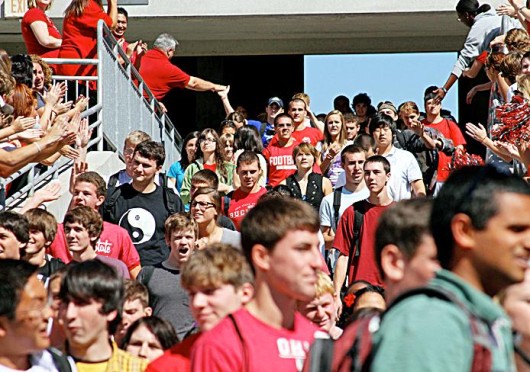
OSU freshmen pour into Ohio Stadium during Autumn Quarter 2010 Freshman Convocation.
Credit: Lantern file photo
Incoming first-year students are often met with a whirlwind of new faces and names at summer events leading up to the start of the academic year. But a new way of organizing student leader positions aims to make the connection between current and incoming students stronger and less confusing.
Although many programs like orientation, Welcome Week, First Year Success Series and the Buckeye Book Community will see only minor changes, First Year Experience will move to a unified peer leader model in the fall, said Bernie Savarese, director of FYE.
“We’ve taken what were many disconnected student leader positions, such as Orientation Leaders, First Year Connections Team, the Transfer Student Activities Board and the Buckeyes Beyond Ohio Activities Board, and will be moving to one, yearlong position in FYE’s First Year Peer Leaders,” Savarese said.
The peer leaders will work to connect with students and build relationships at orientation and through pre-enrollment programs in the summer, Savarese said. They will continue to support the students assigned to them at orientation all throughout the year.
Peer leaders will be expected to work full time in the summer and also 10 hours throughout the week once school begins, said Nicole Craven, assistant director of FYE. Tasks will include leading First Year Success Series sessions, collaborating with campus partners and building relationships with the first-year students.
“These students coming into the university have lots of questions and anxiety and being able to talk to an upper class student who has already been through what they’ve experienced can be really powerful,” Craven said.
The peer leader positions are paid, with students earning $10 per hour through the period of employment. Housing and meals will be provided throughout the summer for peer leaders, according to the FYE website.
By moving to a year-round model, this system will allow students to continue to rely on the peer leaders they meet over the summer and start the year with an upper class mentor in their corner, said Savarese.
“While the professional staff in FYE will work to ensure that our First Year Peer Leaders understand the unique needs of first year students at the various points in the year, we also know that our Peer Leaders can leverage their experiences as students to connect with members of the first-year class in a way that only students can,” Savarese said.
Mo Burke, a third-year in foreign language education, said he thinks that the peer leaders will be beneficial to first-year students, but also thinks first-year students should participate in other FYE programs as well.
“Along with forming relationships with peer leaders, it’s also beneficial for students to participate in programs… in order to make those connections with other first-year students as well,” Burke said.
Savarese said he thinks the peer leader yearlong model will help all first-year students, with a special emphasis on at risk students—students who, because of a variety of factors, might be less successful than their peers.
First-generation college students, as well as students from a lower socio-economic background and students from underrepresented backgrounds, are considered at risk.
“Our First Year Peer Leaders will be trained to engage in direct outreach and support to their students who have the potential to be most at risk,” Savarese said. “In this way, they will be an additional safety net to ensure that all students, no matter their background, are getting connected early and often to the people, information and resources they need to be successful.”


